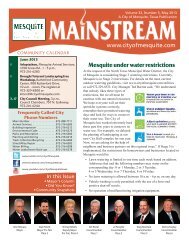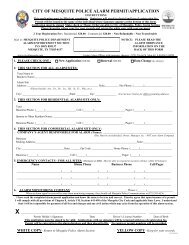airport/documents/Mesquite Master Plan Final.pdf - The City of ...
airport/documents/Mesquite Master Plan Final.pdf - The City of ...
airport/documents/Mesquite Master Plan Final.pdf - The City of ...
Create successful ePaper yourself
Turn your PDF publications into a flip-book with our unique Google optimized e-Paper software.
<strong>The</strong> analysis <strong>of</strong> cab eye elevation must<br />
factor two considerations: determine the<br />
minimum eye level elevation utilizing<br />
the criteria provided in FAA Order<br />
6480.4 and evaluate any structures<br />
located between the ATCT site and<br />
surface movement areas to determine if<br />
they may obstruct the line-<strong>of</strong>-sight. An<br />
obstructed view is commonly referred to<br />
as a shadow. A tall structure which<br />
casts a shadow or loss <strong>of</strong> view <strong>of</strong> a<br />
particular surface area would require<br />
the cab eye elevation to be increased in<br />
order to view the surface area in<br />
question.<br />
Consideration should also be given to<br />
alterations or additions to surface<br />
movement areas. This chapter is<br />
considering runway extension<br />
alternatives that could extend Runway<br />
17-35 from between 1,000 feet and<br />
1,370 feet south.<br />
MINIMUM CAB EYE<br />
ELEVATION ANALYSIS<br />
FAA Order 6480.4 provides a method<br />
for determining the minimum cab eye<br />
elevations for proposed ATCT sites.<br />
This calculation was established to<br />
meet the minimum requirements for<br />
visual depth perception. According to<br />
the Order, the line-<strong>of</strong>-sight from the<br />
tower cab eye level must intersect the<br />
grade <strong>of</strong> the <strong>airport</strong> traffic surface in<br />
question (parking apron, taxiway,<br />
runway, etc.) at an angle <strong>of</strong> 35 minutes<br />
or greater. <strong>The</strong> formula provided in the<br />
Order and utilized in this analysis is as<br />
follows:<br />
4-26<br />
E e = E as + [ D x Tangent (35 minutes + G s) ]<br />
whereas:<br />
E e = Eye level elevation (MSL)<br />
E as = Average elevation for<br />
section <strong>of</strong> <strong>airport</strong> traffic<br />
surface in question<br />
D = Distance from proposed tower<br />
site to section <strong>of</strong> <strong>airport</strong> traffic<br />
surface in question<br />
G s = Angular slope <strong>of</strong> <strong>airport</strong><br />
traffic surface measured<br />
from horizontal and in<br />
direction <strong>of</strong> proposed<br />
tower site<br />
It should be noted that the cab eye<br />
elevation provides the mean sea level<br />
(MSL) or above ground level (AGL)<br />
height at which a controller will be<br />
viewing from. Actual tower heights will<br />
be higher to accommodate the cab ro<strong>of</strong><br />
and necessary antenna equipment. It<br />
can be expected that the actual tower<br />
height will be at least seven feet higher<br />
than the cab eye elevation calculation<br />
indicates.<br />
SITING ANALYSIS<br />
Three sites have been analyzed and are<br />
presented on landside alternatives A, B,<br />
and C. When considering ATCT<br />
locations, it is important to consider all<br />
factors including the cost <strong>of</strong> construction<br />
to both the <strong>City</strong> <strong>of</strong> <strong>Mesquite</strong> and<br />
TxDOT. TxDOT funds the construction<br />
<strong>of</strong> up to two ATCTs per year, and the




